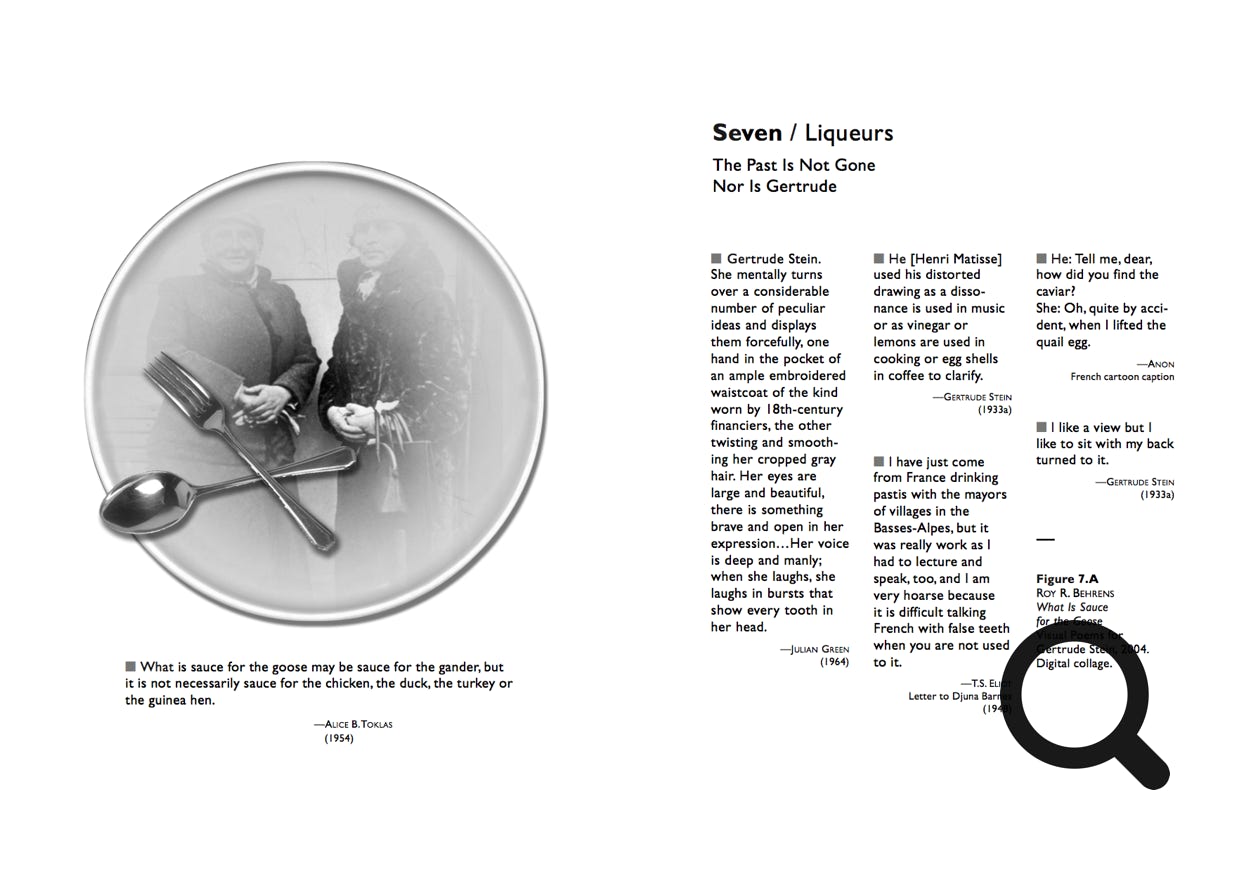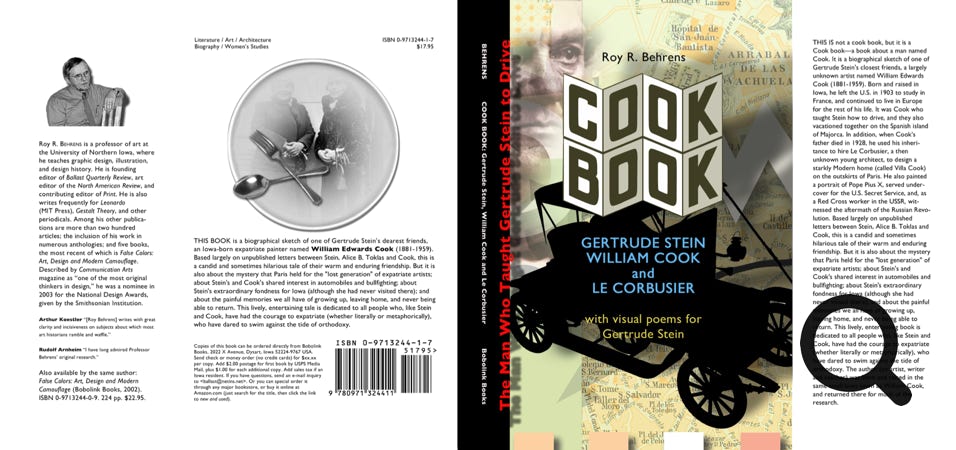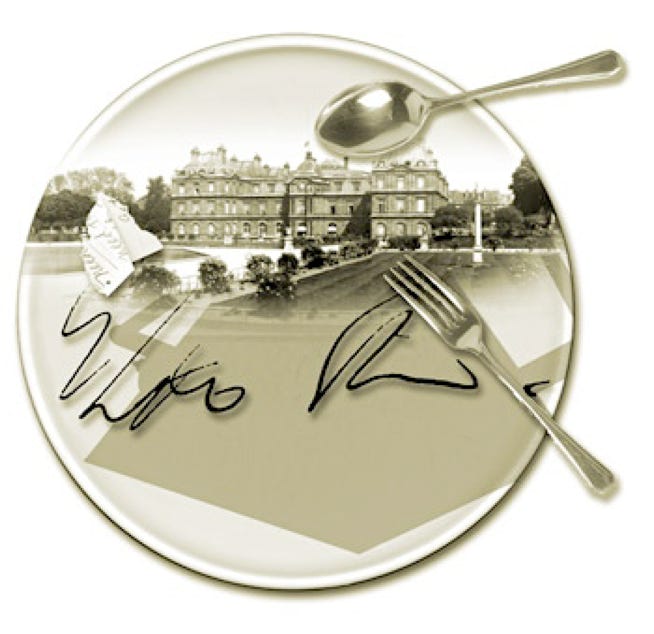
WILLIAM EDWARDS COOK
Le Corbusier’s Iowa client,
and the man who taught
Gertrude Stein to drive
This essay was published initially in The Iowa Source (February 1999), p. 9. Copyright © by the author.
Fred Allen
Before food was invented, books about cooking were rare.
Cicely Gittes
[a friend of the Cooks, in an interview, 1998]
I remember that Cook was always very nice about Le Corbusier, and I have an idea that Le Corbusier was rather a stinker.
Ned Rorem
This summer I saw Picasso after a bullfight in Arles, accosted with the gifts of live infants. With a stroke of charcoal he designs on a baby’s naked ass, and returns this art to the parents. What will they do, skin the child? Refuse it a bath for decades?
•••
Kurt Tucholsky
Once in Spain a society for the protection of animals was founded which was hard up for money. They put on some large bullfights.
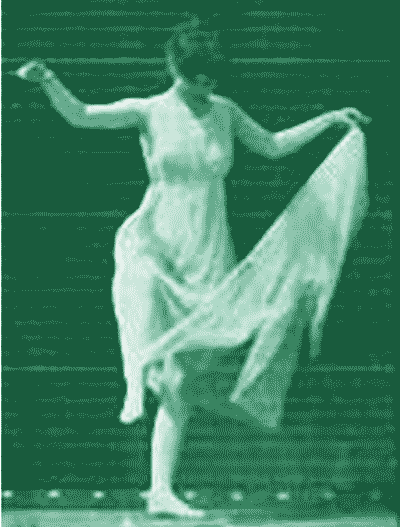
Above An animated dancer made with Eadweard Muybridge still photographs. The dancer is often said to have been Isadora Duncan, but apparently it’s not.
Peter De Vries
I imagined asking her whether she liked Le Corbusier, and her replying, “Love some, with a little Benedictine if you’ve got it.”
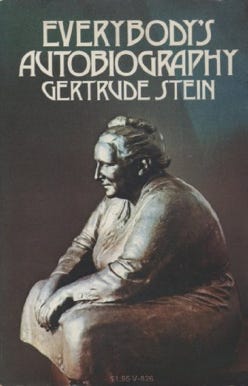
Priscilla J. Henken Taliesin Diary: A Year with Frank Lloyd Wright (New York: W.W. Norton, 2012). Two excerpts from the diary—
Saturday, November 7, 1942 (p. 50):
As for Paris, FLW met Gertrude Stein there. Spoke of her influence on Picasso & the other "moderns," strange because she was the most unattractive, uninteresting & dull person he had ever spoken to. At a lecture she gave, she wore a man's jacket, an ankle-length skirt cut like men's trousers, and he strongly suspects a wig to cover—yes, he really thinks she was bald. Told the derivation of name Alice B. Toklas—Gertie wanted to do all the talking, so she said "Alice, be talkless."
Saturday, January 29, 1943 (p. 109):
[FLW] Described meeting Gertrude Stein in Madison [c1933] on lecture tour—they were invited to her hotel room—she said Wright was familiar to her but she couldn't tell why. Alice B. Toklas sat behind her like a kind of guardian angel, and when they [the Wrights] invited her to the Fellowship, she hesitated, & said, "But we like to fly. We want to fly to Milwaukee." And they nudged and pinched each other, and Alice said, "yes, we like to fly."
•••
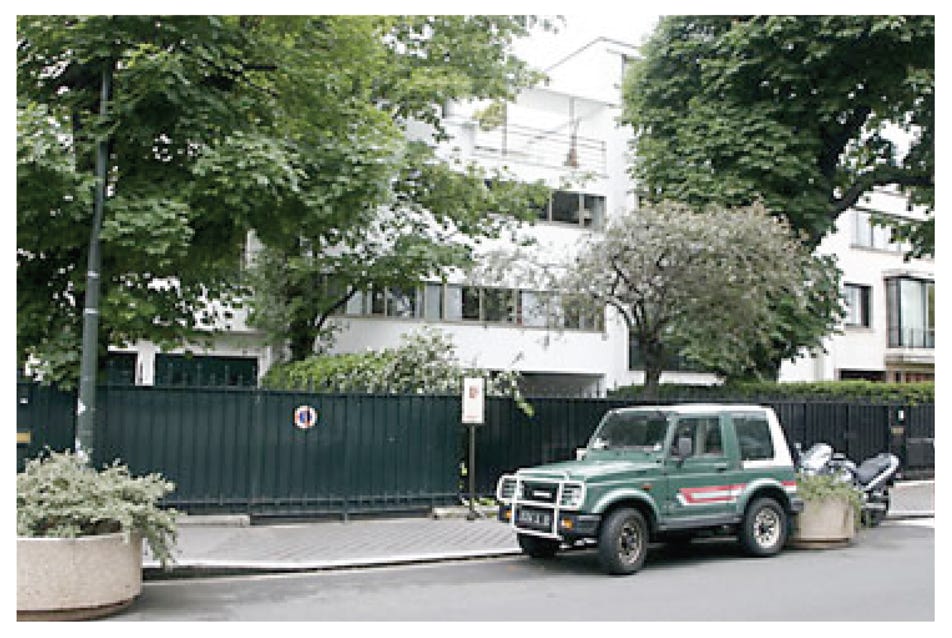
Gertrude Stein
What is so good is that you can be gentle to Iowa. Iowa is gentle.
The French word for raven is le corbeau. Around 1920, the Swiss-French architect Charles-Édouard Jeanneret-Gris (1887-1965) adopted the pseudonym Le Corbusier as a way to allude to the annual task of his forebears during the Middle Ages of cleaning out crows' nests from the local church steeple.
Le Corbusier went on to become one of the most celebrated architects of the twentieth century. What is not commonly known is that one of his early clients was an Iowa-born expatriate artist named William Edwards Cook (1881-1959), for whom he designed an innovative four-level home called Villa Cook or Maison Cook on the outskirts of Paris.
William Cook was born and raised in Independence, Iowa, the county seat of Buchanan County in the northeast region of the state. Inspired by the paintings of J.M.W. Turner and John Singer Sargent (whom he may have known personally), he left home at age 18 to study art, first in Chicago, and then in New York. In 1903, he moved on to Paris, where he studied with Adolphe-William Bouguereau, the famous French Academy painter, now much maligned. Several years later, while visiting Rome, he became the first American artist to be invited to paint a portrait of Pope Pius X.
While living in Paris, Cook became acquainted with the American writer Gertrude Stein, who invited him to her gatherings on Saturday evenings at her home at 27 rue de Fleurus. There he met dozens of now-famous Modernists, among them Stein's companion, Alice B. Toklas; dancer Isadora Duncan; writer Ernest Hemingway; artists Pablo Picasso, Henri Matisse, and Jacques Lipchitz; and many others.
Over the years, Stein and Toklas became close friends of Cook and his French mistress (whom he eventually married), an artist’s model named Jeanne Moallic, who also worked as a femme de menage or house cleaner. As described in Stein's autobiographies (The Autobiography of Alice B. Toklas and Everybody's Autobiography), they vacationed together several times on the Spanish island of Mallorca, where Stein and Cook were avid fans of bullfighting. The two couples delighted in each other’s company, in part because of Jeanne’s mistakes when she tried to speak English (for example, she referred to the two women as “Mlle. Tosca and Miss Steins,” which, she said, as Cook explained to Stein, “is good enough as I know who she means, and you are both so charming that you are not the people to make the ‘chichi’ over a little matter of names”).
While working as a taxi driver in Paris, Cook taught Gertrude Stein to drive, using his two-cylinder Renault taxi cab. As a result, Stein and Toklas as a team were able to contribute to World War I by driving a converted Ford van named “Auntie” (which Stein had purchased through relatives in the US) as a medical supply truck for the American Fund for French Wounded. "Cook does and he says and he is kind to all," Stein wrote admiringly of her friend. "He understands all. He is so kind."
On March 2, 1922, Cook and Jeanne Moallic were married, with Stein and Toklas standing in as witnesses. Like many artists and intellectuals of the time, Cook was interested in Socialism and the Russian Revolution, and at the end of that month, he left for two and a half years on an American Red Cross relief mission to the Caucasus region of the Soviet Union. His wife eventually joined him, but not before Stein had arranged for photographer Man Ray to take photographs of her, to send to her Iowa in-laws.
While living in the Caucasus, the Cooks had tea in Georgia with the American dancer Isadora Duncan and attended her performance at the Tiflis Opera House. Cook wrote to Stein that “it was nice to see someone who had come from the land of the free and the home of the brave,” but he thought her dancing was “a frost.” At age 45, Duncan was losing her figure, and Cook concluded that “there is a certain relation between waistlines and dancing that cannot be gotten away from…”
During those same years, at Stein’s urging, Cook made repeated attempts to assist the family of Picasso’s wife, the Russian ballerina Olga Khokhlova. Her family was living in Tiflis, and Cook had agreed to pass on money to them that Picasso had relayed to him through Gertrude Stein.
Meanwhile, Cook's father, an Independence lawyer and landowner named Justin Cook, died in 1924. Cook used part of his substantial inheritance to buy land and to build a small, innovative home in Boulogne-sur-Seine. While searching for an architect, he was introduced to the then obscure Le Corbusier by the sculptor Jacques Lipchitz, who had just had a similar villa designed by the architect in the same neighborhood.
At the same time, if with some hesitation, Le Corbusier also agreed to design a villa for Michael Stein, Gertude's older brother. He was hesitant because the Steins had furnished their previous home with Italian Renaissance antiques. "Don’t buy anything but practical furniture and never decorative furniture," Le Corbusier advised; and, as he explained to Michael Stein, "I have to be very careful when I take [on] my clients so that they won’t spoil my house with their furniture."
The first formal meeting between the Cooks and Le Corbusier took place April 28, 1926. They must have had few disagreements because the basic plan for the house was completed only three days later on May 1, and the layout was fundamentally unchanged when construction began in July of that year. In contrast, a series of major revisions were made in the design of the Stein villa, so that construction of that project had still not begun when the Cooks moved into their finished home in March of 1927.
This is not to say that everything went smoothly in the construction of the Cook house. In early September, for example, Cook discovered that Le Corbusier (whom he described in a letter to Stein as a "temperamental genius") had mistakenly placed the house beyond his property line, fifty centimeters into his neighbor's land. "I thought this was a thing that was not according to Hoyle," Cook wrote to Gertrude Stein, "and he [Le Corbusier] told me I seemed to be a type absolutely without gratitude. Gratitude be damned says I—What I want is to have the thing fixed up. Well, it will cost me ten thousand francs before the thing is finished and he is mad because I have no appreciation of the fact that he got me fifty centimeters of land I didn’t want."
Several months later, there was another misunderstanding between architect and client. The former may have deliberately underestimated the cost of the project at its outset, in part by allowing for certain details (such as the quality of window glass) to be decided later. While the architect was on vacation, it was Cook who apparently chose to install regular window glass in the windows on the street facade of the building, instead of more costly plate glass.
When the architect returned, he sent Cook a letter demanding a correction: "I am convinced that you will readily agree to it so as to avoid a serious blemish to your property," wrote Le Corbusier, "For you we have made the best of our houses, and one with which we have taken particular trouble. Alas, I fear that you do not appreciate it for what it is, or the distressing incidents which you have caused us would not have happened." After all, he added, "A fine gentleman setting out for a ball would never wear a paper collar with his dinner jacket."
Le Corbusier's early buildings are often characterized as the architectural equivalent of cubist paintings, and he himself described Villa Cook as "the true cubic house" (le vrai maison cubique). The house is a literal cube in the sense that the plan and the elevation are both derived from the same square.
The ground level of Villa Cook is divided into a car port on one side, and a pedestrian entrance and walkway on the other. Raised above ground by pilotis (or stilts) and side walls, the living quarters are housed in a sculptural two-story box, with a curiously inverted room arrangement: The bedrooms, dressing room, bathroom, and the original maid's room are all on the first floor; while the kitchen, dining room, and living room are on the second. The height of the living room is double, so that it flows up into the fourth level, which contains a roof garden and library.
Shortly after his clients moved into their new home, Le Corbusier sent a vase of flowers to Jeanne Cook. "We are more and more pleased with the house day by day," William Cook wrote to the architect, "Mrs. Cook was delighted with the superb arrangement of flowers which she received yesterday evening. The living room is full of them, like a field in springtime." His wife added: "We are very happy and grateful that you have managed to produce not only a great house, but a very pretty one, with so much light and sunshine."
While evidently pleased with their home, the Cooks asked that it be modified several years later by the addition of a separate maid's quarters in the rear, with an outdoor bedroom and recreation area on the floor above. They recommended Le Corbusier to prospective clients, and occasionally showed the interior to acquaintances who were planning to build a house. As Gertrude Stein's friend, William G. Rogers, remarked in his memoir, When This You See Remember Me: Gertrude Stein In Person, Cook was important at the time not as an artist but "largely as the occupant of a house built by Le Corbusier…"
The Cooks moved out of Villa Cook in 1934. They leased it when they moved to Rome and then settled permanently on Mallorca. "Have told Jeanne that if she prefers we can go and live in Iowa," Cook wrote to Gertrude Stein, but "she seems to have leanings toward Palma [de Mallorca], as I have myself." He went on: "She says she likes Iowa, but has the feeling that Paddy [their dog] would not be happy there…"
In October, Gertrude Stein and Alice B. Toklas sailed to America for a six-month book promotion tour. Among their scheduled appearances
was a lecture at the Times Literary Club in Iowa City, on the second floor of what is now the Prairie Lights Bookstore. "Is that anywhere near [his hometown of] Independence [Iowa]?" Stein asked Cook in a letter, "We would love to lecture in Independence but I am afraid it is too far away. It almost feels to us like a home tour." In the end, even her Iowa City lecture was cancelled when her plane was forced to land in Waukesha, Wisconsin, because of a snowstorm.
"I would like to have seen Iowa," Stein recalled later in Everybody's Autobiography, "Carl [Van Vechten, the music critic] and Cook come from Iowa, you are brilliant and subtle if you come from Iowa and really strange and you live as you live and you are always well taken care of it you come from Iowa.”
William Cook died in Mallorca in 1959 at age 78, while Jeanne died two years later. They were buried in a small cemetery in Genova, adjacent to Palma de Mallorca. Surviving both is Villa Cook at 6 rue Denfert Rochereau in Boulogne-sur-Seine, which was described recently in an architectural directory as "almost in original state" and "slightly worn." The building's reputation has also survived: While never regarded as a major work by Le Corbusier, it is often cited as the first implementation of what he and his cousin and partner (Pierre Jeanneret) defined as the "Five Points of a New Architecture."
•••


Mina Loy
[from her poem
about Gertrude Stein]
Curie
of the laboratory
of vocabulary
she crushed
the tonnage
of consciousness
congealed to phrases
to extract
a radium of the word.
•••
Gertrude Stein
[in a letter to Carl Van Vechten, describing her dog’s inability to urinate]: He used to be the roi de pipi and then there was none.
The original version of this essay, as published in The Iowa Source, was somewhat shorter. Three years earlier, I had curated a small exhibition of fourteen paintings by William and Jeanne Cook (lent by Cook’s Iowa relatives) at the Gallery of Art at the University of Northern Iowa in Cedar Falls. This eventually resulted in a small book on the subject titled COOK BOOK: Gertrude Stein, William Cook and Le Corbusier (2005). It recounts in full the story of the Cook-Stein friendship, in large part based on material in the 750 pages of their correspondence in the Beinecke Rare Book and Manuscript Library at Yale University.—RB
Ulla Dydo pre-eminent Stein scholar, regarding Cook Book [2005]: “This book jumps out at my eyes, my ears. It comes from everywhere, never drags those even blocks of print that dull the mind. Look at it, read it, let it tease you: It’s researched with all the care that keeps its sense of humor and its visual and voice delights. Travel with it, leave home, go and explore the many ways for a book to be a house for living.”
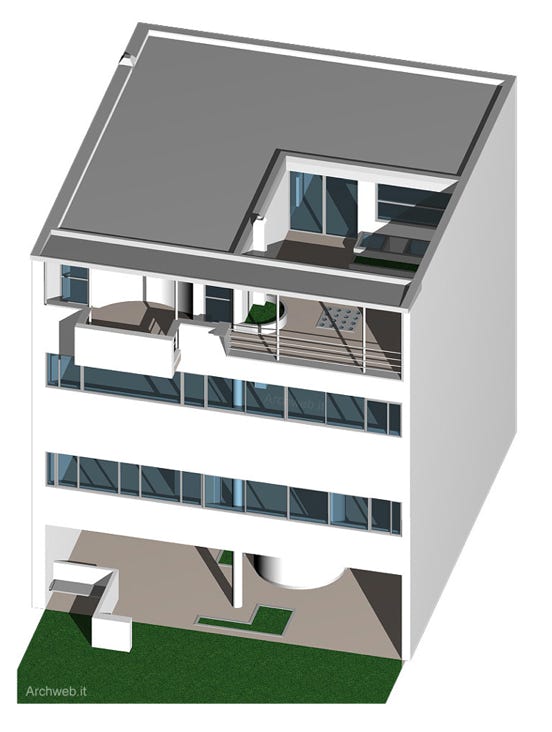
Above Three-dimensional rendering of Villa Cook 6 rue Denfert Rochereau in Boulogne-sur-Seine near Paris. Source / Archweb.It.
Below Recent street views of the same residence.
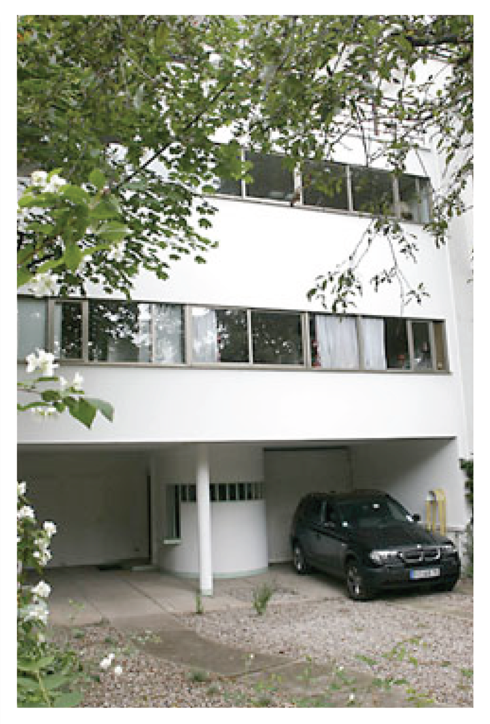
André Wogenscky
[Le Corbusier’s Hands]
He was a very bad diplomat. When I went with him to decisive meetings, I was afraid. Sometimes his major obstacle was himself.
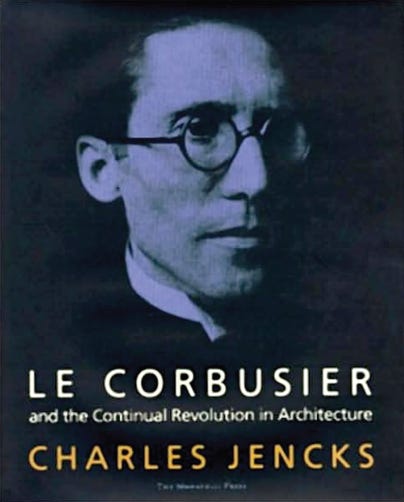
André Wogenscky
[Le Corbusier’s Hands]
Although his architecture was completely thought out in advance, structured, seen by him in his mind before it was built, Le Corbusier loved accidents in his architecture…[because they] introduced an element of randomness in the formal order and disrupted its organization.
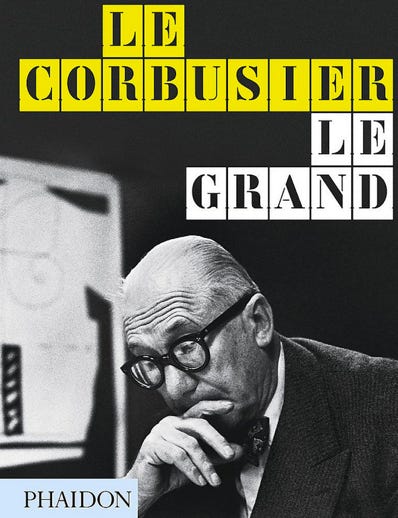
Gertrude Stein
I have a weakness for Iowa. Iowa is different from the others.
